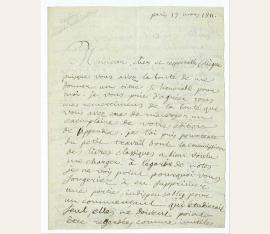French physicist and mathematician (1775-1836). Autograph letter signed ("A. Ampère"). Paris. 01.10.1826. 4to. 1 p. on bifolium. With autogr. envelope.
$ 6,946 / 6.500 €
(49582/BN34021)
To "Mademoiselle Cuvier au jardin des plantes", daughter of the French naturalist, apologizes for delaying in seeing his friend Cuvier, and expresses the hope he may be permitted to visit him that evening to show a scientific instrument, "autrement je le laisserai au domestique, dans le cas je vous supplierai de lui offrir mes voeux pour son heureux voyage et son prompt retour [...]".
French physicist and mathematician (1775-1836). Autograph letter signed ("A. Ampère"). Paris. Large 8vo. 3 pp. on bifolium.
$ 8,015 / 7.500 €
(88567/BN58458)
Probably to the politician and writer Jean-François Roger, editor of a bilingual edition of Joseph de Jouvency's "Appendix de diis et heroibus poeticis" for the study of Ovid. Ampère was charged by the "Commission des livres classiques" of the ministry of public instruction to evaluate the possible use of this publication as a textbook. He advises against discarding any parts of the notes: "indispensable for a beginner who would study alone, they cannot be regarded as useless for students in the various institutions of public instruction" (transl.).
Ampère lauds the translations in "correct French" as "the best manner to make difficult passages understood". The only problem would be "the impossibility to examine pupils based on a copy of the book, where they see what they need to say at the bottom of the page". Therefore, Ampère conceives a system of cross-references that would allow for separating text and translation. But he immediately rejects his own ideas since they "probably have no foundation" and he might appear a second-guesser ("faire complètement le gros-jean"). - Ampère only calls the book in question "Appendix", and it is not quite clear to which edition he refers. Jean-François Roger (1776-1842) had first published his Latin-French version in 1806 and several editions followed when it was adopted as a textbook by the "Commission des livres classiques". Both Roger and Ampère were members of the Commission, and as Ampère addresses the recipient as his colleague, it is very likely that this was indeed Roger. - With a collector’s note in pencil. Minor browning..
Physiker (1775-1836). Eigenh. Brief mit U. Paris. 2 SS. auf Doppelblatt. 4to. Mit eh. Adresse.
$ 10,152 / 9.500 €
(88881/BN58824)
In französischer Sprache an den Astronomen John Herschel mit Dank für dessen mit Charles Babbage verfasste Werke, mit einer Empfehlung des Generals und Ingenieurs Guillaume Piobert, der Herschel in England zu treffen hoffe, und mit dem Bedauern, demselben noch kein Exemplar seiner neuen Schrift über elektrodynamische Phänomene ("Théorie des phénomènes électro-dynamiques [...]", Méquignon-Marvis, 1826) mitgeben zu können: "Monsieur, je désirais depuis longtemps vous écrire pour vous remercier de l'envoi que vous avez bien voulu me faire de plusieurs des ouvrages dont vous êtes l'auteur ou que vous avez publiés en commun avec monsieur Babbage [...] je profite maintenant d'une occasion favorable pour vous faire parvenir celle-ci, Mr.
piobert capitaine d'artillerie et ancien élève de l'école polytechnique, qui a continué de s'occuper utilement des sciences depuis qu'il est sorti de cette école [...] part dans peu de jours pour l'angleterre où il espère avoir l'honneur de vous voir [...] Je regrette beaucoup qu'un ouvrage que j'imprime actuellement sous le titre de théorie des phénomènes électrodynamiques, et qui j'espère achevera complètement tout ce qui se rapporte à la démonstration de la formule fondamentale de cette théorie et aux nombreuses applications de cette formule, ne soit pas achevé d'imprimer pour prier Mr. piobert de vous en porter un exemplaire [...]"..



